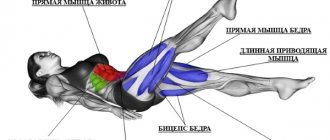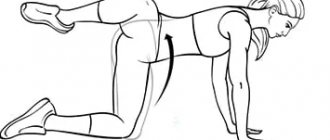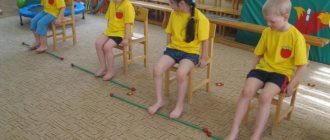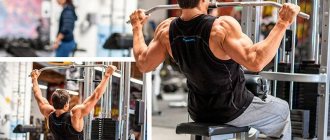( 4 ratings, average: 5.00 out of 5)
Home » Exercises
Statistical loads help direct long-term tension to certain types of muscles. Unlike dynamic impact with its need to move the joints, this option does not involve their movement, so such exercises are recommended at the end of the workout.
For the formation of powerful muscles, the abdominal corner exercise is excellent, which after exposure becomes almost steel. Exercises are often performed on the floor, but variations in physical activity are not limited to this method of execution.
Execution technique
Regardless of the type of exercise, the “base” is the athlete’s positioning of the legs and torso in a position that can be called a straight degree. The position of the back is maintained in a straight position, the legs are tightly connected together, fixation of the position lasts for at least 10 seconds.
Floor
This is where you begin to get acquainted with the statistical load on the abs, but the abdominal muscles are prepared during the transition to the lesson (a series of the classic approach is performed while lying down for 2 weeks). Breathing is voluntary, but as you exhale the muscles tense and then relax. The total time for fixing the legs in the air (per approach) takes 3 minutes, the break duration is 1 minute between sets.
Algorithm:
- lean on your buttocks and stretch your legs;
- lean your body on your hands;
- legs lift off the floor and stretch in the air;
- the limbs are directed towards the body and held.
It is recommended to keep your elbows straight, but a slight bend is allowed. A complicated technique involves placing your hands on the ground and lifting your legs, which become parallel to the floor.
Horizontal bar
Exercising on the horizontal bar is acceptable and beneficial for the abs. Hanging on a sports structure, the athlete raises his legs, holds his breath and pulls his toes towards the body. Experienced athletes take a series of rapid inhalations and exhalations, lowering their limbs in the final part.
Common mistakes:
- arch of the back;
- rocking;
- jumping from the horizontal bar.
When performing the exercise, keep your hands shoulder-width apart; when lowering, your elbows are not apart, but are directed towards the body.
Bars
Advanced load option: on the uneven bars the load is higher, because the athlete does not hang, but maintains the position with his torso using his arms. The athlete jumps onto the bars and tries to raise his legs above the level of the sports structure, and after crossing the mark, he holds the position for 3-5 seconds. The decrease in retention time is dictated by the increased load.
Complicated options for training on uneven bars:
- raise your legs to face level;
- hang weights on your feet;
- increase the holding time to 20 s.
To enhance the impact of the hands, they are bent at the joint (a push-up effect is created).
Swedish wall
At home or in the gym, perform the load comfortably on a wall bars adjacent to the wall of the room. The technique closely resembles the procedure for receiving a load created by a horizontal bar. However, the wall bars provide more options - hanging (while grabbing the top bar) and support (on the side handles). Some models do not contain protrusions, but attachments can be purchased and integrated into an existing structure. Exercises on the wall bars are carried out without lifting your back from the vertical surface.
How to properly make a corner on the floor?
This is a standard abdominal exercise. It is during crunches that the rectus abdominis muscle (responsible for the abs on the abdomen), the pectoralis major muscle, the external and internal obliques, and the transverse abdominal muscles are activated.
Performance. Make sure to keep your middle and lower back pressed to the floor. This way you avoid engaging the hip flexors. Try to keep your hands at your temples, do not reach up with your chin and neck. The abdominal muscles should lift you up. When ascending, you should exhale deeply and inhale in the lower position.
Perform three sets of 30 reps.
Scissors
This exercise is aimed at working the lower abs (abdominal part). Muscles involved in this exercise: iliopsoas, tensor fascia lata, sartorius, rectus femoris, adductor longus and brevis, pectineus, rectus abdominis, oblique and transverse abdominis, and quadriceps.
Performance. Lie on the floor, stretch your arms along your body and press them to the floor. Raise your legs off the floor and perform crossing movements. While performing the exercise, make sure that your lower back is pressed to the floor.
The lower your legs are, the greater the load on your lower abs. If you find it difficult to keep your legs at this level, raise them a little higher. If you feel your lower back lifting off the floor, raise your legs a little higher.
Make sure your legs are straight.
Perform three sets of 30 seconds each.
Diver
This exercise is also aimed at working the lower abs (abdominal part). Muscles involved in this exercise: iliopsoas, tensor fasciae lata, sartorius, rectus femoris, adductor longus and brevis, pectineus, rectus abdominis, oblique and transverse abdominis, and quadriceps.
Performance. Lie on the floor, stretch your arms along your body and press them to the floor. Raise your legs above the floor and perform walking movements with a small amplitude.
Socks should be pulled towards you, your lower back pressed to the floor. The lower your legs are, the greater the load on your lower abs.
If you feel your lower back lifting off the floor, raise your legs a little higher and hold this position. Make sure your legs are straight.
Perform three sets of 30 seconds each.
Crunches with legs raised
This exercise works the rectus abdominis, external oblique, quadriceps, and tensor fasciae lata (thigh muscles). This exercise is more aimed at burning fat, rather than working out the relief.
Performance. Lie on the floor, raise your knees bent (the angle should be 90 degrees), stretch your arms in front of you. Raise your upper body towards your knees, reaching forward with your arms. Exhale while going up, and inhale when going down. Try not to lift your lower back off the floor or lower your legs. Make sure that your chin is not pressed against your neck.
An easier option for performing this exercise is to cross your arms and lie on your chest. More complex - hands are placed behind the head or at the temples.
Perform three sets of 10 reps.
Swing with bent leg
During this exercise, the main load is directed to the oblique abdominal muscles, but the rectus abdominis, quadriceps and tensor fasciae lata (hip muscles) are also worked.
Performance. Lie on the floor, put your hands behind your head, bend your knees. The feet should rest on the floor. Perform a crunch in which the right elbow reaches behind the left knee toward the middle of the thigh and the knee moves toward the elbow.
While performing the exercise, try to raise your upper body so that your shoulder blades come off the floor. The lower back should be pressed to the floor. Do not press your chin to your neck or pull yourself up with your arms.
When twisting, exhale; in the starting position, inhale.
The closer the feet are to the pelvis, the greater the load.
A simpler option for performing this exercise is to stretch the non-working arm to the side (forming a straight line with the shoulder girdle) and press it to the floor. This will give you extra support while twisting.
Perform 30 repetitions on each leg.
Bike
This exercise works the rectus abdominis, external oblique, internal oblique, transverse abdominis, and leg and buttock muscles (gluteus maximus).
Performance. Lie on the floor, place your hands behind your head. Start making movements with your feet as if you were pedaling a bicycle. At the same time, lift your upper body, trying to lift your shoulder blades off the floor.
Alternately stretch your right elbow to your left knee, your left elbow to your right knee. The exercise can be performed at any pace. Try not to press your chin to your chest or pull your head up with your arms.
Don’t forget to breathe correctly: exhale every time you twist.
Perform three sets of 20 reps.
Saw plank
During this exercise, the core muscles (rectus and transverse abdominis, dorsi extensor, trapezius, biceps and pectoral muscles), buttocks and leg muscles (hips and calves) are involved in the work.
Performance. Get into a plank position with your forearms resting. The elbows should be positioned exactly under the shoulders, the stomach should be pulled in (the navel is pulled towards the tailbone), the back should be straight (there should be no arching in the lower back).
In this position, swing with a small amplitude. When moving forward, your shoulders should be in front of your elbows, and when moving back, they should be behind your elbows.
Make sure that your back and legs constantly form a straight line (without bending or, conversely, an arch in the lower back).
Source: https://etazherka.com/kak-pravilno-delat-ugolok-na-polu/
Benefits and harms
The corner is a popular exercise that allows you to form a press with parameters that are in demand in sports competitions. The benefits are also obvious for beginners - the body becomes attractive.
Benefits from doing the lesson:
- elimination of fat deposits on the abdomen;
- increased muscle fiber strength;
- increasing endurance;
- formation of a “wasp waist”;
- reducing the “orange peel” effect.
Threats lie in the strong tension that is exerted on the abdominal muscles, which remain in an unusual state for a long time. If you have certain diseases, harm from exercise is acceptable.
Development of pain syndrome with:
- cystitis;
- vertebral hernia;
- first month after birth;
- postoperative period.
Severe pain is possible in the presence of abdominal, inguinal or umbilical hernia, in which physical activity is completely contraindicated.
Warning: Cannot be performed in the presence of hypertension, arrhythmia, aneurysm.
Nuances
How to perform it correctly and how to learn to do the exercise without discomfort are other important questions that interest “newbies” who have unsuccessfully completed the exercise. Spasms, pain, tension are the consequences of incorrect tactics to give the lower body an attractive appearance.
Before starting a class, beginners make a common mistake - they start without warming up. Achieving a right angle the first time is also problematic, so for “beginners” a gradual increase in height is allowed.
Some athletes lift their limbs jerkily, which is unsafe. Experienced athletes have created other variations of the Corner that help increase the load.
- weights. Objects (light dumbbells) are placed on the ankle. This activity is suitable for people with highly developed abdominal muscles.
- increase in height. The legs are raised to an increased height. The load increases the flexibility of the body.
- leg spread. Classic execution on a horizontal surface, but with the limbs open. Holding each leg separately helps develop your thigh muscles.
- bent leg. The second limb remains straight (alternately changing), the exercise helps to tighten the oblique abdominal muscles.
Unlike other exercises, it allows you to visually highlight all six abs, but other techniques often do not allow you to work out the lower 2 abs. Muscle blocks are hidden behind a layer of fat, which can be easily removed with static exercise.
It is not recommended to do it in an overexcited state: the smoothness of the movements requires the presence of inner peace.
Standards for angle support on parallel bars
The angled parallel bar position is one of the most common exercises among athletes and gymnasts. To perform this simple trick, you need to position yourself between two parallel bars.
They come in both wood and metal. The body should be in a strictly vertical position, while the arms, resting on the bars, are parallel to the body in a slightly straightened position.
The torso itself is straightened, the legs are extended, and the toes are extended and brought together.
Standards at school: corner 90 in support on uneven bars
Looking from the outside, this exercise looks quite simple to perform. However, having tried for the first time without proper preparation, the decision to give up will appear already in the fifth second. The most important thing in successful training for endurance and long-term holding of the angle is given to the press. The abdominals are the most important and decisive element in performing this exercise.
Note, the title “God of Workout” must hold the corner for 80 seconds
To effectively train your abdominal muscles, you need to:
- Take a position, resting your hands on the bars and bring your feet together. In this position, you need to straighten your back and try to raise your legs, bent at the knees, as high as possible.
- The next position is in the same position, only the legs are extended down. Thus, when performing the exercise, you need to place your legs as high as possible on the bars.
- When it becomes easier to do this, you can complicate the task.
- When performing the previous exercise, you need to hold the position of your legs at the highest point of the lift for several seconds and repeat this exercise regularly during training for several approaches.
Such warm-ups can be performed on horizontal bars, on rings, on the floor, or by installing supports from chairs, books or other improvised means.
Speaking in the language of an athlete, the technique for performing this task can be of several types, depending on the specific desired result and the goal of which muscles should be pumped.
Corner on the floor:
- It is necessary to take the starting position, sitting on the buttocks. Having positioned yourself in this way, you need to slightly tilt your arms back and lean on them. Having fixed your back straight, raise your legs together upward and hold in this position for 25-30 seconds, 3-5 approaches.
- The next position is with your hands on the floor, raising your buttocks so that they do not touch the surface. When performing this exercise, when the buttocks are lifted off the floor, the pelvis moves slightly backward.
- This exercise is difficult to perform, so you can first keep your outstretched legs parallel to the ground. Then, as you progress, understand your legs higher and higher.
Thus, during the execution, it is allowed to support a friend when learning the action and provide insurance. It is strictly forbidden for an assistant to place his hands between the athlete’s body and the bars.
As with everything, a beginner makes many mistakes while training on an angle while leaning on the uneven bars.
Categories of errors during training:
- Not significant - when incorrect position, bending or spreading of the legs is allowed.
- Significant - when the arms are bent at the elbows, located at different distances relative to the body, or the poles of the bars are allowed to touch.
By performing such an angle, an inexperienced athlete can harm his body. So, it is better to abandon the idea for those who have heart problems or too low a physical level of training.
It should be noted the positive results of push-ups on the uneven bars during such training:
- Development of the shoulder and elbow joint, wrist and other muscles of the body.
- Strengthening the muscles of the body.
- Formation of relief on the pectoral muscles.
- Getting rid of scoliosis. Complete spinal alignment.
- Developing endurance, balance and dedication to purpose
Consequently, by regularly and systematically performing pull-ups on parallel bars, many muscles and joints are loaded at once. In addition, such training can easily replace going to the gym in terms of effectiveness.
It should be noted that when training on parallel bars, the maximum load goes to:
- First of all, on the muscles of the upper limbs - since it is the arms that hold the torso in position, during push-ups and performing corners with the help of the legs
- Muscles of the upper limbs and muscles of the hands
- The triceps muscles of the shoulders also come into action
- Quadriceps femoris muscle.
These are not all muscle areas involved in performing an angle on the uneven bars. In general, almost all muscles are involved in such training.
And noting the last feature, the workouts are divided into two categories:
- Dynamic - when an abdominal pumping exercise is performed by lifting the legs up and down without stopping.
- Static - when lifting your legs above the bars, you are fixed in such a defeat for some time. However, this method is very difficult and puts a huge load on the hands.
Thus, by performing regular loads and pumping up your abdominal muscles, after some time it will be quite easy to perform an angle on the uneven bars correctly and for the benefit of the body.
Source: https://RunetMir.com/sportnorm/normativy-ugolok-v-upore-na-brusyax
What to replace
Running frog
If there are physical limitations or difficulties in performing the activity, it is wise to choose alternative options for exposure, but also those that will also help to draw the relief.
- Press while standing. Having taken a position against the wall, a person alternately raises his limbs and connects them with the lowering arm.
- Wah. The athlete grabs the horizontal bar and bends his legs at the joints. The torso rises 25 times. The recommended number of sets is 3, breaks between sets are half a minute.
- Bike. It is practiced on the uneven bars, imitating the movements that are used when riding a bicycle. Work until you feel tired.
- D. In the prone position, the legs are raised and touch the outstretched arms (palms facing down). The exercise is made easier by relieving tension from the back. A set for taking the “G” position consists of 10–20 repetitions.
- Twisting on blocks. The athlete kneels, grabs the cable and, as he exhales, begins to bend towards the floor. As you inhale, you return to the starting position.
It is also useful to use a sports bench, which will help to effectively work out the lower abs.
Exercise "corner" for the press
The abdominal corner exercise is one of the most effective static tools for pumping up the abdominal muscles. Unlike dynamic loads, which promote muscle growth and the appearance of relief, static exercises allow you to increase muscle fiber strength and develop endurance.
Therefore, the “corner” abdominal exercise is less suitable for beginners. In addition, in order to achieve a toned figure, it is better to spend more time during the training process on dynamic exercises, and leave static ones to “finish off” the trained muscles at the very end.
There are different variations of this exercise for different levels of training of the athlete. Next, we will look at the features of each of them, study the technique of execution, and also find out the effect on specific muscles when choosing a certain type of “corner”.
The most popular types of this exercise are as follows:
- Corner on the floor;
- Corner on the wall bars;
- Corner on the horizontal bar.
Features of preparation
As can be seen from the technique of execution, this exercise will require the use of your arms - albeit small, but if you have very weak ones, then at some point you will stop progressing in abdominal exercises precisely because of your arms, which will not be able to hold the body straight in for a long time. If you encounter such a problem, we recommend alternating the corner with push-ups to strengthen the arm muscles. In addition, for progress on the abs, we recommend alternating the corner with strength exercises for the abs, for example, sit-ups and V-sit-ups - then the effect will be maximum!
If exercises in this form are difficult, you can make the method of execution a little easier. For example, it is much easier to perform a “corner” with your legs tucked to your chest:
© zinkevych — stock.adobe.com
Common mistakes
As with any other exercise in a corner on the floor, athletes make a number of mistakes when performing it. Let's look at them.
- Bend in the knee joints is considered a mistake. Legs remain straight with toes pointed forward throughout the entire workout. But! If you are a beginner athlete and you cannot hold out for 10 seconds any other way, then this option is acceptable during the first training sessions in the strengthening process.
- Shoulders should be raised. It is unacceptable to pull your shoulders into yourself.
"Corner" on the wall bars
The “corner” exercise can also be performed on a wall bars using hanging bars. This is a more advanced version of the corner - here you need to have sufficiently trained hands, and also the angle of the exercise itself becomes sharper, which undoubtedly complicates it.
Execution Features
As mentioned earlier, a “corner” using a wall bars is performed based on its configuration: bars, a horizontal bar or just a ladder rung.
To train on parallel bars, you need to have strong forearms that can support your body weight for quite a long time. The main work is also done by the lower abs and upper thighs.
Additionally, biceps and triceps are included. During the first training sessions, it is permissible to raise your legs in a bent position.
"Corner" on the horizontal bar
This type of exercise “corner” for the press is performed in a hanging position with straight arms on a horizontal bar.
This is the most difficult of all the third types presented in the material, as it involves the maximum number of muscles and requires good preparation from the athlete.
Straight legs are raised to parallel with the floor and fixed for the maximum possible time for the athlete. Thus, the main load falls on the rectus and oblique abdominal muscles, and indirectly on the front surface of the thigh.










